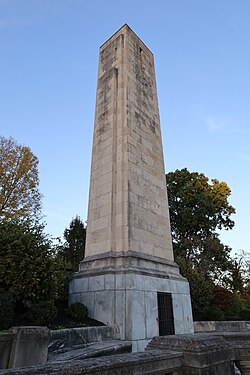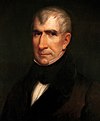
William Henry Harrison was an American military officer and politician who served as the ninth president of the United States. Harrison died just 31 days after his inauguration as president in 1841, making his presidency the shortest in U.S. history. He was also the first U.S. president to die in office, causing a brief constitutional crisis since presidential succession was not then fully defined in the United States Constitution. Harrison was the last president born as a British subject in the Thirteen Colonies and was the paternal grandfather of Benjamin Harrison, the 23rd president of the United States.

Arlington National Cemetery is one of two cemeteries in the United States National Cemetery System that are maintained by the United States Army. Nearly 400,000 people are buried in its 639 acres in Arlington County, Virginia.

A mausoleum is an external free-standing building constructed as a monument enclosing the burial chamber of a deceased person or people. A mausoleum without the person's remains is called a cenotaph. A mausoleum may be considered a type of tomb, or the tomb may be considered to be within the mausoleum.
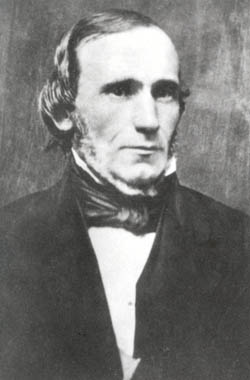
John Scott Harrison was an American politician who served as a member of the United States House of Representatives from Ohio from 1853 to 1857. He was a son of U.S. president William Henry Harrison and First Lady Anna Harrison as well as the father of U.S. president Benjamin Harrison. He is the only person to have been both the son and father of U.S. presidents.

Grouseland, the William Henry Harrison Mansion and Museum, is a National Historic Landmark important for its Federal-style architecture and role in American history. The two-story, red brick home was built between 1802 and 1804 in Vincennes, Indiana, for William Henry Harrison (1773–1841) during his tenure from 1801 to 1812 as the first governor of the Indiana Territory. The residence was completed in 1804, and Harrison reportedly named it Grouseland due to the abundance of grouse in the area.

Graceland Cemetery is a large historic garden cemetery located in the north side community area of Uptown, in Chicago, Illinois, United States. Established in 1860, its main entrance is at the intersection of Clark Street and Irving Park Road. Among the cemetery's 121 acres (49 ha) are the burial sites of several well-known Chicagoans.

Hollywood Cemetery is a historic rural cemetery located at 412 South Cherry Street in the Oregon Hill neighborhood of Richmond, Virginia. It was established in 1847 and designed by the landscape architect John Notman. It is 135-acres in size and overlooks the James River. It is the only cemetery other than Arlington National Cemetery that contains the burials of two United States Presidents, James Monroe and John Tyler.
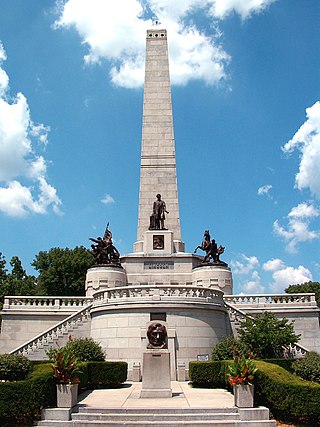
The Lincoln Tomb is the final resting place of Abraham Lincoln, the 16th president of the United States; his wife Mary Todd Lincoln; and three of their four sons: Edward, William, and Thomas. It is located in Oak Ridge Cemetery in Springfield, Illinois.
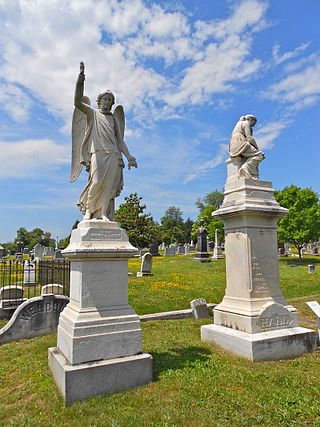
The Congressional Cemetery, officially Washington Parish Burial Ground, is a historic and active cemetery located at 1801 E Street, SE, in Washington, D.C., on the west bank of the Anacostia River. It is the only American "cemetery of national memory" founded before the Civil War. Over 65,000 individuals are buried or memorialized at the cemetery, including many who helped form the nation and the city of Washington in the early 19th century.

The Harding Tomb is the burial location of the 29th President of the United States, Warren G. Harding and First Lady Florence Kling Harding. It is located in Marion, Ohio. Also known as the Harding Memorial, it was the last of the elaborate presidential tombs.

Oak Ridge Cemetery is an American cemetery in Springfield, Illinois.

Crown Hill Cemetery is a historic rural cemetery located at 700 West 38th Street in Indianapolis, Marion County, Indiana. The privately owned cemetery was established in 1863 at Strawberry Hill, whose summit was renamed "The Crown", a high point overlooking Indianapolis. It is approximately 2.8 miles (4.5 km) northwest of the city's center. Crown Hill was dedicated on June 1, 1864, and encompasses 555 acres (225 ha), making it the third largest non-governmental cemetery in the United States. Its grounds are based on the landscape designs of Pittsburgh landscape architect and cemetery superintendent John Chislett Sr and Prussian horticulturalist Adolph Strauch. In 1866, the U.S. government authorized a U.S. National Cemetery for Indianapolis. The 1.4-acre (0.57 ha) Crown Hill National Cemetery is located in Sections 9 and 10.

Laurel Hill Cemetery, also called Laurel Hill East to distinguish it from the affiliated West Laurel Hill Cemetery in Bala Cynwyd, is a historic rural cemetery in the East Falls neighborhood of Philadelphia. Founded in 1836, it was the second major rural cemetery in the United States after Mount Auburn Cemetery in Boston, Massachusetts.

Oakwood Cemetery is a nonsectarian rural cemetery in northeastern Troy, New York, United States. It operates under the direction of the Troy Cemetery Association, a non-profit board of directors that deals strictly with the operation of the cemetery. It was established in 1848 in response to the growing rural cemetery movement in New England and went into service in 1850. The cemetery was designed by architect John C. Sidney and underwent its greatest development in the late 19th century under superintendent John Boetcher, who incorporated rare foliage and a clear landscape design strategy. Oakwood was the fourth rural cemetery opened in New York and its governing body was the first rural cemetery association created in the state.

The James A. Garfield Memorial is a memorial for and the final resting place of assassinated President James A. Garfield, located in Lake View Cemetery in Cleveland, Ohio. The memorial, which began construction in October 1885 and was dedicated on May 30, 1890, exhibits a combination of Byzantine, Gothic, and Romanesque Revival architectural styles. Garfield, former First Lady Lucretia Garfield, and two other members of the Garfield family are entombed in the crypt level of the monument.

The Public Vault at the Congressional Cemetery in Washington, D.C. is an early classical revival structure built 1832–1834 with funds appropriated by the United States Congress to store the bodies of government officials and members of the public before burial. About 4,600 individuals were temporarily interred in the vault, including three U.S. presidents, First Lady Dolley Madison, and sixteen congressmen who died while serving in office.
Congress Green Cemetery is a historic military cemetery in North Bend, Ohio, near Cincinnati.
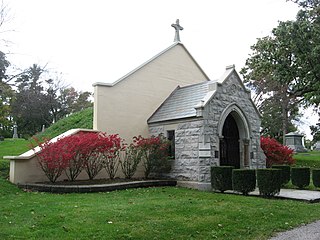
The Marion Cemetery Receiving Vault is a funerary structure in the main cemetery of Marion, Ohio, United States. Constructed in the 1870s, this receiving vault originally fulfilled the normal purposes of such structures, but it gained prominence as the semipermanent resting place of Marion's most prominent citizen, U.S. President Warren G. Harding.
